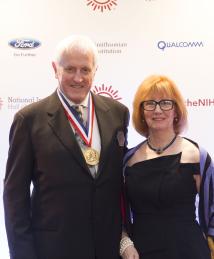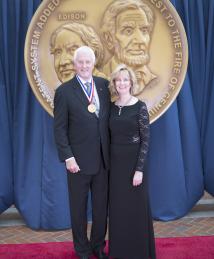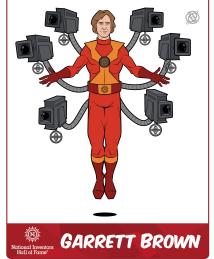Garrett W. Brown
"The thing that you come up with may have seemed impossible to somebody. That's the payoff down the road when you're an inventor: if you score something that people want and love."
Garrett Brown invented the Oscar-winning Steadicam® camera stabilizer, ushering in new technology that allowed movie and television directors and cinematographers to capture previously impossible sequences.
Born in 1942 in Long Branch, New Jersey, Brown grew up in Havertown, Pennsylvania. His father worked as a chemist at DuPont, and his mother was an English teacher. Though Brown was drawn to literature and music, his father, who had invented the “hot-melt” adhesives used to hold together magazines and paperback books, encouraged him to follow a more technical path. “My dad talked up inventing,” Brown recalled. “There was an atmosphere of discussing science in our house.”
Following his high school graduation, Brown enrolled at Tufts University on a Navy scholarship, but he soon chose a more creative pursuit. Joining fellow Tufts student Al Dana to form the folk duo “Brown & Dana,” he left college to devote his time to music. The pair released their first album in 1963, and they performed at more than 100 colleges and folk clubs over the next three years. “It was the most fun you could ever imagine,” Brown said.
After a car crash and the advent of the Beatles, Brown worked as a Volkswagen salesman, sold his one-and-only short story and became a copywriter at an ad agency, where he wrote and eventually produced award-winning ads. It wasn’t until a friend loaned him a Bolex film camera that Brown began his journey toward the film industry.
Interested in the technical side of moviemaking, Brown and his friend Warren Paul started the Moving & Talking Picture Co. of Philadelphia, New York, and Gradyville. Working mainly on commercials for cars dealers, banks and insurance companies, they eventually met with two challenges – the bulkiness of their traditional camera dolly and the inability to capture steady, moving shots on foot.
To solve these problems, Brown developed a number of prototypes. His first used a simple pole with a weighted T-bar made of plumbing pipe and lead ingots, and continued to experiment until he arrived at the ideal way to bear the weight of a 1970s 35mm camera – which became the Steadicam®. This body-mounted stabilization device permitted camera operators to freely walk, run or climb stairs while their shots remained smooth. A vest-like harness supported an iso-elastic arm connected to a gimbaled camera mount, allowing unwanted motions to be isolated and absorbed.
To demonstrate his final prototype, Brown filmed his future wife Ellen running through fields, across alleys, and up and down stairs. “I could show up with a reel of 30 impossible shots, obviously impossible to anybody that knew anything, and not give them a clue of how it was done,” Brown said. “So, that demo was seen by industry titans around the world and just knocked down the doors. It just floored everybody.”
Early examples of Brown’s Steadicam footage can be found in films including “Bound for Glory” and “Rocky,” both released in 1976, “The Shining” in 1980 and “Star Wars: Episode VI - Return of the Jedi” in 1983. The Steadicam has since been used in countless movie and television productions worldwide. Explaining the appeal of filming sequences with a Steadicam, Brown said, “A problem for everyone in the business was that, as delightful as it is to handhold a camera, the results are so un-human, so inevitably shaky. Storytelling shots draw less attention to themselves if they are smooth.”
In addition to the Steadicam, Brown invented the Emmy-winning Skycam camera system that flies on wires over sporting events; the MobyCam that tracks swimmers underwater; the DiveCam, which drops alongside divers; the FlyCam that soars over linear events like rowing and skiing; and recently, the Emmy-winning Steadicam Volt™ that electronically augments the skills of Steadicam Operators. Brown also led the development of Zeen®, an innovative mobility device designed to allow users to transition from seated to standing positions and easily walk or coast, without the risk of falling.
Brown holds more than 120 patents and has worked on nearly 100 films, and he continues to invent and inspire. His many awards include an Academy Award of Merit in 1978 for Steadicam, the Scientific and Engineering Award from the Academy of Motion Picture Arts and Sciences in 2006 for Skycam, and the Charles F. Jenkins Lifetime Achievement Award, presented in 2015 at the Television Academy’s 67th Engineering Emmy Awards for his “continuous invention of camera-stabilization products and techniques [that have] changed the visual language of filmed storytelling.”
Looking toward the future of American innovation, Brown said, “It's so urgent that our population, our kids understand that inventing is something that anyone can do, and the way of it isn't mysterious. It’s almost fun!"






